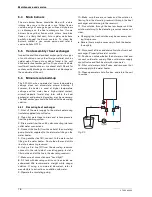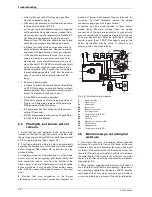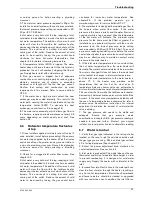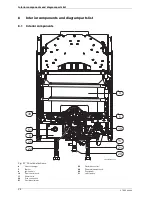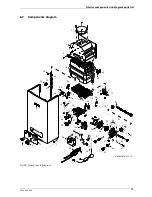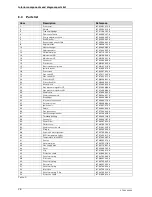
6 720 644 942
22
Troubleshooting
the water heater should be cleaned and inspected. See
chapter 5.2.
5. If the water has a high mineral content, the heat
exchanger may be scaled internally. This restricts the
water path, causing the water to boil and produce
extremely hot temperatures. To descale the heat
exchanger, section 5.6 on page 18.
6.8
Water is not hot enough
1. Verify that gas type indicated in the rating sticker
located on the cover's right hand side coincides with
the gas type you are using. NG is a natural gas unit and
LP is for liquid propane (see chapter 2.2).
2. Flow at one particular tap is too great or too many
fixtures are running at one time. Lower flow to stay
within the heater's specifications.
3. Ensure that the gas control knob is all the way
counter-clockwise for highest temperatures. In addition,
the flow control knob maybe set too high. Raise the
setting by turning the knob clockwise for higher
temperatures.
4. Close installer supplied cold water shut off valve (if
none installed, install before proceeding). Open every
hot water tap supplied by the heater. Wait 5 minutes
and check all taps. Any water running, even a trickle, is
a sign of a plumbing crossover. Consult local plumber
or service person for help correcting a plumbing
crossover.
5. Inspect the water path outside the heater for
obstructions. Make sure all showerheads, faucet
aerators and whole house filters are clear of debris.
Also, the water heater's inlet filter should be inspected
and cleaned. See chapter 5.2.
6. The water valve assembly, which allows gas flow to
the burners, requires periodic maintenance (every 2-5
years depending on water quality and use). See
section 5.2.
7. Gas pressure is too low. Ensure that gas pressure
meets specifications meets chapter 3.9. A gas pressure
reading is needed to proceed further. Contact your
original installer or a local gas technician to obtain this
reading.
6.9
Low hot water pressure
1. Confirm adequate flow rate through the unit. With
cold supply shut off to the unit, disconnect hot outlet
side to the unit. Place a gallon jug under hot water
outlet to catch water. Open cold water supply and
measure flow rate out of the unit. With temperature
adjustment knob set all the way clockwise, the flow rate
should be close to 2GPM (filling the jug in 30 seconds
or less). If the flow rate is not adequate, inspect and
clean inlet filter screen. See chapter 5.2.
2. Confirm that the incoming water pressure to the unit
is above the minimum required pressure of 30psi.
3. Inspect the water path outside the heater for
obstructions. Make sure all showerheads, faucet
aerators and whole house filters are clear of debris.
4. Be sure to run only one major fixture at a time with this
water heater. Opening too many taps at one time can
disperse water flow resulting in diminished flow or
pressure at all outlets.
6.10 Noise when heater is running
If the water has a high mineral content, the heat
exchanger may be scaled internally. This restricts the
water path, causing the water to boil resulting in noise
and overheating. To descale the heat exchanger,
consult section 5.6 on page 18.
6.11 Burners do not burn cleanly, yellow
flames when operating
1. Verify that gas type indicated in the rating sticker
located on the heater's right hand side, coincides with
the gas type you are using. NG is a natural gas unit and
LP is for liquid propane (see chapter 2.2).
2. For proper combustion at high elevations the inlet
gas pressure must be set at installation to the values in
table 3 on page 11 (while operating at maximum BTU).
A gas pressure reading is needed to proceed further.
Contact your original installer or a local gas technician
to obtain this reading.
3. Combustion air is inadequate. Ensure that adequate
combustion air is being supplied to the unit in
accordance with requirements in the installation
manual. See chapter 3.3.
4. Verify that the water heater is vented properly. Ensure
that the venting meets requirements in chapter 3.6.
5. If the burner flames burn yellow or orange the burners
must be removed from the unit and cleaned. Once the
burners are removed, the fins in the top of the heat
exchanger can be accessed from below and brushed or
vacuumed clean. Consult service bulletin CT-13 on
www.boschpro.com for removing and cleaning the
burners.











